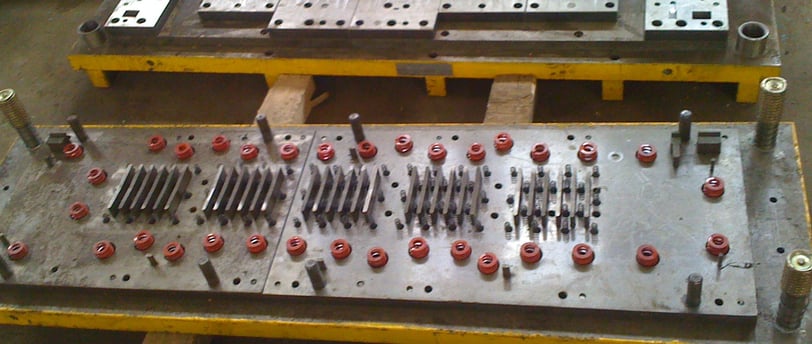In-Depth Analysis: The Application and Advantages of Continuous Stamping Die
2/11/2025


Understanding Continuous Stamping Die: Definition and Mechanism
Continuous stamping dies represent a crucial innovation in the field of metal forming processes. They are sophisticated tools utilized for the mass production of metallic parts through the application of progressively shaped stamps within a mechanized system. This approach allows for a highly efficient workflow, enabling the processing of various materials, including steel, aluminum, and other alloys. The design mechanisms of continuous stamping dies typically consist of a series of sequential stamping stations, each configured for the precise shaping of a specific component in the overall production sequence.
The operational principles of continuous stamping revolve around material deformation, which is achieved via a series of controlled presses. As the material, often provided in coil form, progresses through the stamping die, it undergoes various stages of transformation. Each station applies force to the material, gradually yielding the final product with minimal waste. The integration of automation in this process not only enhances speed but also maintains accuracy across high-volume production, making continuous stamping an ideal choice for industries requiring large quantities of consistent components.
Continuous stampinging dies can be differentiated from other metal forming techniques by their ability to produce complex geometries in a single cycle. Unlike traditional stamping, which typically relies on discrete cycles for each part production, continuous stamping provides a streamlined, uninterrupted process. This efficiency significantly reduces labor costs and processing times, making it a more favorable option for manufacturers aiming to optimize productivity. Furthermore, the precision of continuous stamping allows for the fabrication of tight tolerances, which is critical in sectors such as automotive and aerospace manufacturing. Overall, the design and operation of continuous stamping dies highlight their advantages in producing high-quality, cost-effective stamped components.
Industries Utilizing Continuous Stamping Dies
Continuous stamping dies are invaluable across various industries, serving as a core technology in modern manufacturing processes. The automotive industry exemplifies one of the most significant applications of continuous stamping dies. Automakers utilize these dies to produce components such as chassis parts, brackets, and transmission housings with unparalleled precision and speed. This capability enhances the efficiency of mass production, fulfilling the high-demand cycles typical of the automotive sector.
Another prominent sector benefiting from continuous stamping dies is the electronics industry. Manufacturers employ these dies for creating intricate metal components used in devices such as smartphones, computers, and home appliances. By using continuous stamping processes, companies can achieve tight tolerances and high repeatability, essential for ensuring the reliability and performance of electronic devices.
The appliance industry also reaps benefits from continuous stamping dies, where the need for durability and aesthetics in parts is paramount. Components such as doors, frames, and internal mechanisms can be produced with minimal waste and consistent quality, aligning with the industry's standards for energy efficiency and sustainability.
Moreover, metal fabrication extensively utilizes continuous stamping technology. This sector encompasses a wide array of applications, including the production of fasteners, brackets, and structural components. Continuous stamping dies facilitate the rapid creation of these parts, significantly reducing lead times and increasing throughput. As a result, fabricators can cater to custom orders while maintaining stringent quality control across the production process.
In conclusion, the versatility of continuous stamping dies allows their integration into various industries, from automotive to electronics, appliances, and fabrication. Each sector leverages this technology to achieve enhanced efficiency, productivity, and quality in manufacturing, showcasing the critical role of continuous stamping within contemporary industrial applications.
Advantages of Continuous Stamping Dies
Continuous stamping dies offer a multitude of benefits that significantly enhance the efficiency and effectiveness of production processes across various industries. One of the primary advantages of employing continuous stamping dies is their cost efficiency. By facilitating high-volume production without the need for extensive machine setup time or labor, manufacturers can achieve lower per-unit costs, thereby optimizing their operational budgets.
In addition to cost savings, continuous stamping dies are characterized by their ability to achieve high production rates. This is particularly advantageous in industries where demand fluctuates rapidly, requiring manufacturers to respond quickly without sacrificing quality. Continuous stamping processes can produce a far greater number of parts in a shorter time frame compared to traditional methods, which often require longer cycle times and more frequent setups.
Precision is another hallmark of continuous stamping dies, making them invaluable for applications that require strict adherence to dimensional specifications. The integration of advanced technologies in die design ensures that the components produced are not only uniform but also exhibit a high level of reliability. This precision minimizes the incidence of defects, thereby reducing the need for rework and enhancing overall production efficiency.
Moreover, the use of continuous stamping dies results in reduced labor costs. Since these systems typically require fewer operators once set up, companies can allocate their workforce to other crucial areas within the operation. This reallocation of human resources contributes to overall productivity improvements across the manufacturing floor.
Finally, the application of continuous stamping dies minimizes material waste. By maximizing material utilization and producing consistent parts, manufacturers can significantly reduce scrap rates. This is particularly important in industries where raw material costs can be substantial, thus enhancing economic sustainability in the long run. Such attributes make continuous stamping dies an increasingly preferred choice among manufacturers aiming to streamline their processes and enhance product quality.
Future Trends and Innovations in Continuous Stamping Die Technology
The continuous stamping die technology landscape is on the verge of significant transformations driven by advancements in various sectors. One of the primary areas of evolution is the improvement in computer-aided design (CAD). Contemporary CAD systems are becoming increasingly sophisticated, enabling engineers to design more complex die geometries with enhanced accuracy and efficiency. These systems facilitate simulations and prototype testing, significantly reducing the development time and costs associated with creating new stamping dies. As such, designers can swiftly address potential design flaws and optimize performance before production begins.
Moreover, the materials used in die manufacturing are also witnessing innovations. Traditional die materials often face challenges like wear and fatigue over time, which can compromise the quality of stamped parts. In response to this, research is actively focused on developing advanced materials that possess superior hardness and wear resistance. For instance, the introduction of high-speed steel (HSS) and carbide-coated dies can lead to increased longevity and productivity in the stamping process, thus reducing downtime and maintenance costs.
Another significant trend is the rise of automation within stamping operations. The implementation of robotic systems and intelligent automation technologies is enhancing operational efficiency and accuracy in the stamping process. Such automation not only speeds up production but also minimizes human error, leading to more consistent quality in the final products. Furthermore, the integration of the Internet of Things (IoT) into stamping processes allows for real-time monitoring and data collection, providing operators with insights that can inform maintenance schedules and quality control measures.
However, despite these advancements, the continuous stamping die industry faces challenges such as managing costs and maintaining quality amid increasing production demands. Addressing these challenges will require innovative solutions, potentially including the adoption of sustainable practices that can minimize waste and energy consumption. Overall, the future of continuous stamping die technology is shaped by these emerging trends and innovations, which promise to enhance operational effectiveness and sustainability in the industry.
